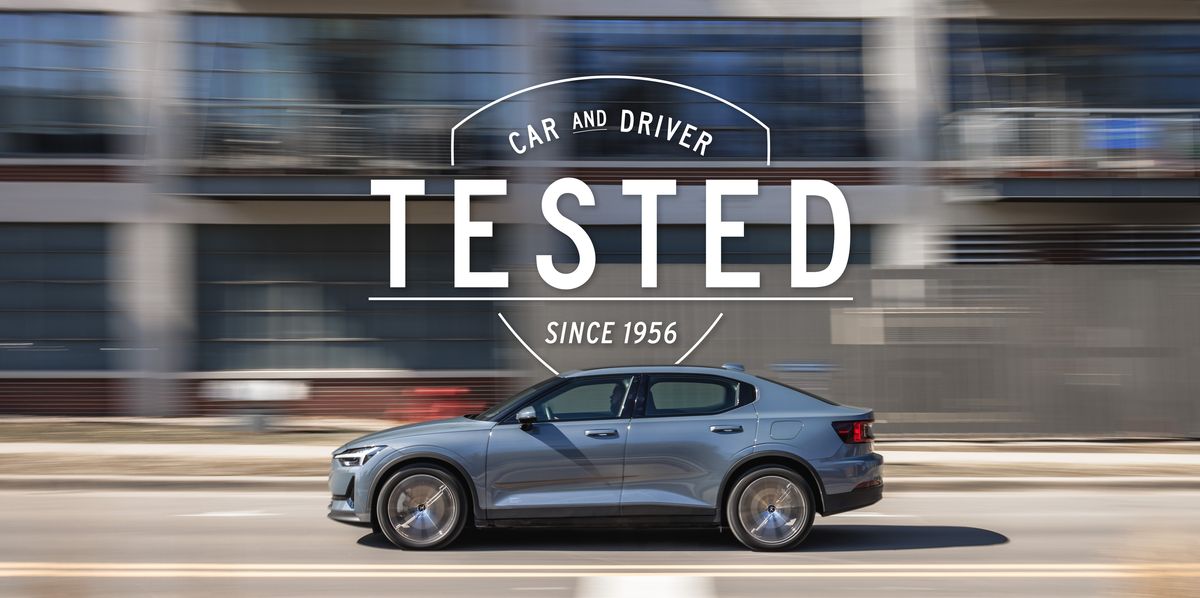2022 Polestar 2 Travels 220 Miles on a Full Charge on the Highway

The single-motor 2022 Polestar 2 traveled 220 miles in our 75-mph highway range test, 50 miles short of its 270-mile EPA-rated range.We conducted the same test with a dual-motor 2021 Polestar 2 that fell 20 miles short of that mark, traveling 200 miles total.The extra mass and mechanical drag caused by the second motor is likely the primary source of the dual-motor model’s shorter real-world range.
Welcome to Car and Driver’s Testing Hub, where we zoom in on the test numbers. We’ve been pushing vehicles to their limits since 1956 to provide objective data to bolster our subjective impressions (you can see how we test here). A more comprehensive review of the 2022 Polestar 2 can be found here.
The 2022 Polestar 2 with one electric motor is expected to travel 270 miles on a full charge, according to its EPA rating. In our 75-mph highway range test, the front-drive model traveled 220 miles before the battery was depleted. That is 20 miles farther than we achieved with a 2021 Polestar 2 with the dual-motor, all-wheel-drive powertrain wearing the same 19-inch Michelin Primacy 4 tires, and 30 miles farther than a Performance package Polestar 2 on stickier 20s.
Despite sharing the same 75.0-kWh battery, we recognize that these two Polestar 2s aren’t a perfect apples-to-apples comparison. That’s because—along with Polestar adding a new single-motor variant for the 2022 model year—the company also introduced “controller software and vehicle efficiency improvements” that it says increase the dual-motor model’s range estimate from 233 to 249 miles. While this extra range can be unlocked on any 2021 Polestar 2 via over-the-air updates, the dual-motor cars we tested were before that update was released.
With that being said, their battery capacity remains the same, so we don’t think the software change will cause significant differences in our highway range results between the single- and dual-motor variants. Traveling at a steady 75 mph on identical interstate routes, the single-motor Polestar 2 will provide a longer range than its dual-motor counterpart. And there are a couple of technical reasons for that.
The increased mechanical drag that’s caused by the additional unclutched drive shafts on the second motor is likely most responsible for the reduced range with that configuration. Another factor is the increased mass, which is simply a byproduct of adding a second motor. As a point of comparison, the dual-motor variant we tested had a curb weight of 4714 pounds. That’s 254 pounds heavier than the single-motor version, which tipped our scales at 4460 pounds.
Michael SimariCar and Driver
At the end of the day, 20 or 30 miles of real-world highway range is a pretty small delta between the Polestar’s two powertrain configurations. When it comes down to deciding which one to choose, it’s more likely that price and performance will play a bigger role. The 2022 Polestar 2 single-motor model starts at $47,200 (not including the available $7500 federal tax credit). Opting for the second motor costs at least $4000 more, but it also provides much quicker acceleration and a more engaging experience behind the wheel.
The single motor’s 231 horsepower and 243 pound-feet of torque led to an unremarkable 6.8-second sprint to 60 mph. Meanwhile, the dual motors combine for 408 horses and 487 pound-feet, helping the EV hit 60 in just 4.1 ticks. Those power figures can be raised even further to 476 and 502, respectively, with the purchase of a new over-the-air performance update. So, if we had to take our pick, we’d sacrifice a little bit of range and prioritize quickness over maximum range.
This content is imported from {embed-name}. You may be able to find the same content in another format, or you may be able to find more information, at their web site.
This content is created and maintained by a third party, and imported onto this page to help users provide their email addresses. You may be able to find more information about this and similar content at piano.io



